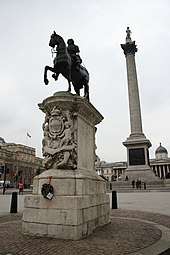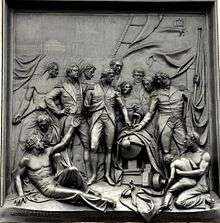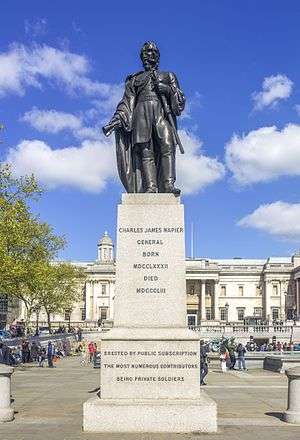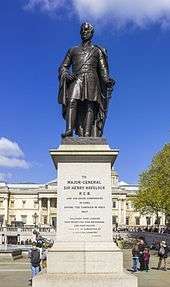List of public art in Trafalgar Square and the vicinity
This is a list of public art in and around Trafalgar Square in the City of Westminster, London.

Charing Cross, at the junction of Strand and Whitehall, was the site of the first public monument in what is now the City of Westminster,[1] the cross commissioned by Edward I late in the 13th century in memory of his queen, Eleanor of Castile. Destroyed by order of the Long Parliament in 1647,[2] the Eleanor cross was replaced after the Restoration by the equestrian statue of Charles I by Hubert Le Sueur, the oldest public sculpture now standing in the borough.[3] In 1865 a facsimile of the cross was erected in the forecourt of Charing Cross railway station. Charing Cross was declared the official centre of London in 1831[4] and a plaque marking this status was installed near Le Sueur's statue in 1955.[5]
Immediately to the north of Charing Cross lies Trafalgar Square, one of London's most famous public spaces.[6] Conceived as part of John Nash's urban improvements, the square was initially developed from the 1820s onwards.[7] Its centrepiece, Nelson's Column, was constructed in 1839–1842. Charles Barry's 1840 redesign of the square provided plinths for equestrian monuments to George IV and William IV, but sufficient funds were never raised for the latter statue.[8] Most of the memorials since added have had a military or naval flavour, an exception being the statue of the physician Edward Jenner, erected in 1858 but moved to Kensington Gardens only four years later. Another work which originally stood on the square is Hamo Thornycroft's statue of General Gordon; this was removed during World War II and reinstalled on the Victoria Embankment in 1953.
Since 1999 the formerly empty fourth plinth on Trafalgar Square has become London's most prominent showcase for temporary new sculpture.[9]
Charing Cross
| Image | Title / subject | Location and coordinates |
Date | Artist / designer | Architect / other | Type | Designation | Notes |
|---|---|---|---|---|---|---|---|---|
 More images |
Statue of Charles I | Charing Cross 51.5073°N 0.1277°W |
1633 | Hubert Le Sueur | Christopher Wren | Equestrian statue | Grade I | The earliest Renaissance-style equestrian statue in England. Originally commissioned in 1630 by Charles I's Lord High Treasurer, Lord Richard Weston, for his estate in Roehampton. Erected on the site of the Charing Cross in 1674–1675, when it was set on its current pedestal.[10] The reliefs were carved by Joshua Marshall, Master Mason to Charles II.[11] |
Charing Cross station
| Image | Title / subject | Location and coordinates |
Date | Artist / designer | Architect / other | Type | Designation | Notes |
|---|---|---|---|---|---|---|---|---|
.jpg) More images |
Queen Eleanor Memorial Cross Eleanor of Castile |
Forecourt of Charing Cross railway station 51.5084°N 0.1254°W |
1865 | Thomas Earp | Edward Middleton Barry | Memorial with sculpture | Grade II* | A replica of the original Eleanor cross at Charing, with some details inspired by the Oxford Martyrs' Memorial. It stands some distance away from the original location of the Charing Cross.[12] |
| Platform murals | Charing Cross tube station | 1979 | David Gentleman | N/A | Murals | N/A | The murals on the Northern line platforms depict the construction of the medieval Charing Cross; they are reproduced from woodcuts by Gentleman at twenty times their original size.[13] The murals for the Jubilee and Bakerloo lines feature photographs of Nelson's Column and paintings in the National Gallery.[14] |
Cockspur Street
| Image | Title / subject | Location and coordinates |
Date | Artist / designer | Architect / other | Type | Designation | Notes |
|---|---|---|---|---|---|---|---|---|
| Commerce | Norway House | 1914 | Louis Frederick Roselieb | Metcalfe & Greig | [15] | |||
| Transport | Norway House | 1914 | Louis Frederick Roselieb | Metcalfe & Greig | [15] | |||
| Industry | Norway House | 1914 | Louis Frederick Roselieb | Metcalfe & Greig | [15] | |||
| Communications | Norway House | 1914 | Louis Frederick Roselieb | Metcalfe & Greig | [15] | |||
 |
Asia and Britannia | Brazilian Embassy | 1918 | Ernest George Gillick | H. W. Stock and A. T. Bolton | Caryatids | Grade II | [16] |
 |
Statue of Olaf II of Norway | Norway House | Gustav Lærum | Johannes Thorvaldsen Westbye (Modification of building by Metcalfe & Grieg) | Statue in niche |
St Martin's Place
| Image | Title / subject | Location and coordinates |
Date | Artist / designer | Architect / other | Type | Designation | Notes |
|---|---|---|---|---|---|---|---|---|
_(cropped).jpg) More images |
Memorial to Edith Cavell | St Martin's Place 51.5093°N 0.1272°W |
1920 | George Frampton | N/A | Pylon with sculpture | Grade I | Unveiled 17 March 1920 by Queen Alexandra. The earliest World War I memorial project in England; plans for it began soon after Cavell's death in 1915. The inscription FOR KING AND COUNTRY was felt to be a travesty of Cavell's beliefs; in 1924 another was added with her words, PATRIOTISM IS NOT ENOUGH/ I MUST HAVE NO HATRED OR/ BITTERNESS FOR ANYONE.[17] |
National Portrait Gallery
| Image | Title / subject | Location and coordinates |
Date | Artist / designer | Architect / other | Type | Designation | Notes |
|---|---|---|---|---|---|---|---|---|
| Thomas Babington Macaulay, 1st Baron Macaulay | St Martin's Place façade (over entrance) | Ewan Christian | Grade II | |||||
| Philip Stanhope, 5th Earl Stanhope | St Martin's Place façade (over entrance) | Ewan Christian | Grade II | |||||
| Thomas Carlyle | St Martin's Place façade (over entrance) | Ewan Christian | Grade II | |||||
| William Lodge | St Martin's Place façade (facing north) | Ewan Christian | Grade II | |||||
| Thomas Fuller | St Martin's Place façade | Ewan Christian | Grade II | |||||
| James Granger | St Martin's Place façade (facing north) | Ewan Christian | Grade II | |||||
| William Faithorne | St Martin's Place façade (facing north) | Ewan Christian | Grade II | |||||
| Edward Hyde, 1st Earl of Clarendon | St Martin's Place façade | Ewan Christian | Grade II | |||||
| Horace Walpole | St Martin's Place façade | Ewan Christian | Grade II | |||||
| Hans Holbein the Younger | Irving Street façade | Ewan Christian | Grade II | |||||
| Sir Anthony van Dyck | Irving Street façade | Ewan Christian | Grade II | |||||
| Sir Peter Lely | Irving Street façade | Ewan Christian | Grade II | |||||
| Sir Godfrey Kneller | Irving Street façade | Ewan Christian | Grade II | |||||
| William Hogarth | Irving Street façade | Ewan Christian | Grade II | |||||
| Sir Joshua Reynolds | Irving Street façade | Ewan Christian | Grade II | |||||
| Louis-François Roubiliac | Irving Street façade | Ewan Christian | Grade II | |||||
| Sir Thomas Lawrence | Irving Street façade | Ewan Christian | Grade II | |||||
| Sir Francis Leggatt Chantrey | Irving Street façade | Ewan Christian | Grade II |
Trafalgar Square
| Image | Title / subject | Location and coordinates |
Date | Artist / designer | Architect / other | Type | Designation | Notes |
|---|---|---|---|---|---|---|---|---|
.jpg) More images |
Statue of George IV | North-eastern plinth, Trafalgar Square 51.5083°N 0.1276°W |
1830 | Francis Legatt Chantrey | Charles Barry | Equestrian statue | Grade II | Originally intended to be the crowning feature of Marble Arch, the decorative scheme of which was cut back after George IV's death. The statue still had no home after Chantrey's death in 1843 and in December of that year it was erected in the newly laid-out Trafalgar Square.[18] |
 More images |
Statue of Horatio Nelson, 1st Viscount Nelson | Centre of Trafalgar Square 51.5077°N 0.1279°W |
1839–1842 | Edward Hodges Baily | William Railton | Statue on column | Grade I | Nelson is shown without an eyepatch, but his portrayal in this statue is not idealised by the standards of the time. The figure is given stability by the coil of rope behind. Portland stone was chosen over bronze as the statue "would [then] not be resorted to as plunder in revolutions".[19] |
More images |
The Battle of Trafalgar or The Death of Nelson | South face of pedestal of Nelson's Column | 1846–1849 | John Edward Carew | N/A | Bas-relief | Grade I | Nelson is depicted immediately after receiving his mortal wound; Captain Hardy turns back towards him whilst sailors to the left take aim at the marksman who dealt the fatal blow. Inscribed at the bottom ENGLAND EXPECTS EVERY MAN WILL DO HIS DUTY.[20] |
.jpg) More images |
The Battle of the Nile | North face of pedestal of Nelson's Column | 1846–1850 | William F. Woodington | N/A | Bas-relief | Grade I | Nelson has been taken below deck after being wounded in the head during the attack on the French fleet in Abu Qir Bay. Captain Edward Berry stands by his side.[21] |
 More images |
The Bombardment of Copenhagen | East face of pedestal of Nelson's Column | 1846–1854 | John Ternouth | N/A | Bas-relief | Grade I | Nelson, on board his flagship HMS Elephant, applies his seal to an ultimatum directed at the Crown Prince of Denmark. The city of Copenhagen is visible in the background.[22] |
.jpg) More images |
The Battle of Cape St Vincent | West face of pedestal of Nelson's Column | 1846–1854 | Musgrave Watson and William F. Woodington | N/A | Bas-relief | Grade I | Nelson is on board a Spanish ship, the San Nicolas. A Spanish officer kneels in front of Nelson, surrendering the swords of his fellow officers. Watson died in 1847 before he could complete the work.[23] |
 More images |
Statue of Charles James Napier | South-western plinth, Trafalgar Square 51.5077°N 0.1286°W |
1855 | George Gammon Adams | N/A | Statue | Grade II | Unveiled 26 November 1856. Napier holds a scroll out in his right hand, a gesture which symbolises the giving of government to Sindh. The statue was much criticised, The Art Journal calling it "perhaps the worst piece of sculpture in England".[24] |
 More images |
Statue of Henry Havelock | South-eastern plinth, Trafalgar Square 51.5079°N 0.1274°W |
1861 | William Behnes | N/A | Statue | Grade II | Unveiled 10 April 1861. The pedestal is inscribed at the front with a quotation from one of Havelock's pre-battle speeches, and to the rear with a list of British and Indian regiments commanded by him during the Indian Mutiny. This was the first statue ever to be modelled from a photograph.[25] |
 More images |
Four lions | At the foot of Nelson's Column | 1867 | Edwin Landseer | N/A | Statues | Grade I | Unveiled 31 January 1867. Landseer, an animal painter with no previous experience in sculpture, was assisted by Carlo Marochetti.[26] |
 More images |
Bust of John Jellicoe, 1st Earl Jellicoe | Balustrade of Trafalgar Square 51.5083°N 0.1278°W |
1948 | Charles Wheeler | Edwin Lutyens | Bust | Grade II* | The Jellicoe and Beatty memorials were unveiled on 21 October 1948 (Trafalgar Day) by the Duke of Gloucester. Each memorial consists of a fountain (adapted from those designed by Charles Barry and installed in 1845) with two bronze sculptural groups and, up against the north wall of the square, a bust of the admiral in question.[27] |
 |
Jellicoe Memorial Fountain | Western fountain of Trafalgar Square 51.5080°N 0.1284°W |
1948 | Charles Wheeler | Edwin Lutyens | Fountain with two sculptural groups | Grade II* | For both memorial fountains Lutyens retained Barry's cusped quatrefoil-shaped basins and added the vase-shaped central fountains. In the Jellicoe fountain, one of the bronze groups comprises a mermaid with two merchildren and dolphins perched on a shell; the other has a triton with a merchild and dolphins on a shell.[27] |
 More images |
Bust of David Beatty, 1st Earl Beatty | Balustrade of Trafalgar Square 51.5084°N 0.1277°W |
1948 | William McMillan | Edwin Lutyens | Bust | Grade II* | During the 2003 refurbishment of the square the busts were moved to the eastern side of the new steps; they previously faced their associated fountains.[27] A square plaque near the centre of the square marks the dedication of the fountains and busts:
THESE FOUNTAINS AND/ THE BUSTS AGAINST THE/ NORTH WALL OF THE/ SQUARE WERE ERECTED/ BY PARLIAMENT TO THE/ MEMORY OF THE ADMIRALS OF/ THE FLEET EARL JELLICOE/ AND EARL BEATTY TO THE/ END THAT THEIR ILLUSTRIOUS/ SERVICES TO THE STATE/ MIGHT NEVER BE FORGOTTEN[28] |
 |
Beatty Memorial Fountain | Eastern fountain of Trafalgar Square 51.5081°N 0.1277°W |
1948 | William McMillan | Edwin Lutyens | Fountain with two sculptural groups | Grade II* | One bronze sculptural group consists of a mermaid riding on a dolphin and holding smaller dolphins under her arms, with a shoal of small sharks in the rear; the other depicts an equivalent grouping with a triton in place of the mermaid.[27] |
 More images |
Bust of Andrew Cunningham, 1st Viscount Cunningham of Hyndhope | Balustrade of Trafalgar Square 51.5083°N 0.1280°W |
1967 | Franta Belsky | N/A | Bust | Grade II* | Unveiled 2 April 1967 by the Duke of Edinburgh. The bust contains a half-pint bottle of Guinness and a note written by the sculptor.[29] |
 |
Endangered Species and portrait heads | Grand Buildings, Strand and Northumberland Avenue | c. 1991 | Barry Baldwin | Sidell Gibson and Associates | Reliefs | N/A | |
| Tile murals | Subway under Trafalgar Square | 1992 | FreeForm Arts Trust | N/A | Tile murals | N/A | A scheme depicting scenes from the history of Trafalgar Square.[30][31] |
National Gallery
| Image | Title / subject | Location and coordinates |
Date | Artist / designer | Architect / other | Type | Designation | Notes |
|---|---|---|---|---|---|---|---|---|
More images |
Statue of James II | Lawn in front of the National Gallery, Trafalgar Square 51.5085°N 0.1291°W |
1686 | Peter Van Dievoet and Laurence Vandermeulen for the Workshop of Grinling Gibbons | N/A | Statue | Grade I | Commissioned by the royal servant Tobias Rustat for a site outside the Palace of Whitehall. One of three statues of Stuart monarchs commissioned by him, the others being those of Charles II at the Chelsea Royal Hospital and Windsor Castle. It was erected on the present site in 1946.[32] |
| Europe and Asia | National Gallery (main portico) | Charles Rossi | William Wilkins | Reliefs | Grade I | |||
| Victories and other female figures | National Gallery (east and west entrance porticoes) | William Wilkins | Statues in niches | Grade I | ||||
 |
Minerva (originally Britannia) | National Gallery (east façade) | John Flaxman; completed by Edward Hodges Baily | William Wilkins | Architectural sculpture | Grade I | ||
More images |
Statue of George Washington | Lawn in front of the National Gallery, Trafalgar Square 51.5087°N 0.1276°W |
1921 | Gorham Manufacturing Company, after Jean-Antoine Houdon | N/A | Statue | Grade II | Unveiled 30 June 1921. A bronze cast of Houdon's 1796 marble statue for the Virginia State Capitol. The state of Virginia offered the cast to London in 1914 to mark the centenary of the Treaty of Ghent, and thus of Anglo-American peace.[33] |
St Martin-in-the-Fields
| Image | Title / subject | Location and coordinates |
Date | Artist / designer | Architect / other | Type | Designation | Notes |
|---|---|---|---|---|---|---|---|---|
 |
Royal Coat of Arms | Portico of St Martin-in-the-Fields | c. 1721–1726 | Christopher Cass, Senior | James Gibbs | Pediment relief | Grade I | [34] |
More images |
John Law Baker Memorial Drinking Fountain | Churchyard of St Martin-in-the-Fields 51.5087°N 0.1263°W |
1886 | ? | N/A | Drinking fountain with sculpture | Grade II | A truncated fluted column with lion's-head fountains on two sides, their basins now filled in. Inscribed IN MEMORY OF JOHN LAW BAKER/ FORMERLY OF THE MADRAS ARMY/ BORN 1789—DIED 1886.[35] |
 |
William Gilson Humphry Memorial Drinking Fountain | Adelaide Street, adjacent to corner with Duncannon Street 51.5087°N 0.1260°W |
1886 | ? | N/A | Drinking fountain | Grade II | A basic granite drinking fountain set into the churchyard wall of St Martin's, where Humphry was vicar from 1815 until his death in 1886. Restored with a replica bronze lion mash spout in about 1989, but this is no longer visible on the memorial.[36] |
 More images |
A Conversation with Oscar Wilde | Adelaide Street, near St Martin-in-the-Fields 51.5088°N 0.1259°W |
1998 | Maggi Hambling | N/A | Memorial with sculpture | N/A | Unveiled 30 November 1998. A bronze sculpture of Wilde's head and hand (complete with cigarette) emerges from a granite, coffin-shaped plinth. Inscribed with a quotation from Lady Windermere's Fan (1892): We are all/ in the gutter/ but some of us/ are looking at/ the stars.[37] |
 More images |
Christ Child | Portico of St Martin-in-the-Fields 51.5088°N 0.1271°W |
1999 | Michael Chapman | N/A | Sculpture | N/A | A relief of a newborn baby with the umbilical cord still uncut, seemingly emerging from a block of Portland stone. The inscription running around the sides reads IN THE BEGINNING/ WAS THE WORD—AND THE/ WORD BECAME FLESH/ AND LIVED AMONG US/ St John 1:1,14.[38] |
 |
Poem
Natalie Skilbeck |
North of St Martin-in-the-Fields 51.5090°N 0.1261°W |
2008 | Tom Perkins (lettering) | Eric Parry | Inscription around balustrade | N/A | The balustrade of a light well is inscribed with a poem by Andrew Motion in stainless steel letters, individually cast.[39] Natalie Skilbeck was a traveller on her gap year killed in a road accident in Mauritius in 2004.[40] |
South Africa House
| Image | Title / subject | Location and coordinates |
Date | Artist / designer | Architect / other | Type | Designation | Notes |
|---|---|---|---|---|---|---|---|---|
More images |
Statue of Bartolomeu Dias | South Africa House, Trafalgar Square | 1934 | Coert Steynberg | Herbert Baker | Statue in niche | Grade II* | [41] |
 More images |
Winged springbok | South Africa House, Trafalgar Square | 1934 | Charles Wheeler | Herbert Baker | Architectural sculpture | Grade II* | [42] |
References
- Ward-Jackson 2011, p. xix.
- Mace 2005, p. 23.
- Westminster City Council, p. 8.
- White 2011, p. 101.
- "Charing Cross", Oxford Index, Oxford University Press, retrieved 3 October 2013
- Trafalgar Square, Greater London Authority, retrieved 28 February 2015
- Bradley & Pevsner 2003, p. 285.
- Mace 2005, p. 111.
- "Public art in London", Museum of London blog, Museum of London, 14 November 2012, retrieved 7 February 2014
- Ward-Jackson 2011, pp. 288–291.
- "Drawing", British Museum Collection Database, retrieved 3 April 2012
- Historic England. "Queen Eleanor Memorial Cross (1236708)". National Heritage List for England. Retrieved 20 November 2013.
- Webb & Skipwith 2009, pp. 76–77.
- Ovenden 2013, p. 249.
- Sculptural Decoration on Norway House by Louis Frederick Roslyn (1878–1934), 9 August 2011, archived from the original on 20 June 2013, retrieved 12 April 2013
- Bradley & Pevsner 2003, p. 339.
- Ward-Jackson 2011, pp. 245–258.
- Ward-Jackson 2011, pp. 293–295.
- Ward-Jackson 2011, pp. 278–279.
- Ward-Jackson 2011, pp. 280–281.
- Ward-Jackson 2011, pp. 281–282.
- Ward-Jackson 2011, p. 282.
- Ward-Jackson 2011, pp. 283–284.
- Blackwood 1989, p. 257.
- Blackwood 1989, p. 258.
- Ward-Jackson 2011, pp. 284–287.
- Ward-Jackson 2011, pp. 300–303.
- "Jellicoe & Beatty", London Remembers, retrieved 17 August 2014
- "Bust of Viscount Cunningham of Hyndhope by Franta Belsky", Your Archives, The National Archives, archived from the original on 24 February 2013, retrieved 10 October 2011
- Pearson, Lynn, "Postwar murals database", Academia.edu, retrieved 17 August 2014
- "Tile mural in Trafalgar Square, London", The Joy of Shards, retrieved 17 August 2014
- Ward-Jackson 2011, pp. 291–293.
- Ward-Jackson 2011, pp. 299–300.
- Bradley & Pevsner 2003, p. 292.
- "John Law Baker fountain", London Remembers, retrieved 20 April 2013
- "St Martin-in-the-Fields Churchyard", London Gardens Online, London Parks & Gardens Trust, retrieved 25 April 2013
- Ward-Jackson 2011, pp. 4–5.
- Ward-Jackson 2011, pp. 248–249.
- St Martin-in-the-Fields Poem, Modus Operandi, retrieved 22 September 2014
- Two die in gap year accidents, BBC News, 28 October 2004, retrieved 29 July 2012
- Ben Weinreb, ed. (2008). The London Encyclopaedia (Third ed.). pp. 866–876. ISBN 978-1-4050-4924-5.
- WHEELER, SIR CHARLES Archived 2011-10-06 at Archive.today Accessed 23 August 2010
Bibliography
- Blackwood, John (1989), London's Immortals: The Complete Outdoor Commemorative Statues, London and Oxford: Savoy Press, ISBN 978-0951429600CS1 maint: ref=harv (link)
- Bradley, Simon; Pevsner, Nikolaus (2003), London 6: Westminster, The Buildings of England, London and New Haven: Yale University Press, ISBN 978-0-300-09595-1CS1 maint: ref=harv (link)
- Mace, Rodney (2005), Trafalgar Square: Emblem of Empire, London: Lawrence and Wishart, ISBN 1-905007-11-6CS1 maint: ref=harv (link)
- Ovenden, Mark (2013), London Underground by Design, London: Penguin, ISBN 978-1846144172CS1 maint: ref=harv (link)
- Ward-Jackson, Philip (2011), Public Sculpture of Historic Westminster: Volume 1, Public Sculpture of Britain, 14, Liverpool: Liverpool University Press, ISBN 978-1-84631-691-3CS1 maint: ref=harv (link)
- Webb, Brian; Skipwith, Peyton (2009), David Gentleman: Design, Woodbridge: Antique Collectors' Club, ISBN 978-1851495955
- Westminster City Council, Statues and Monuments in Westminster: Guidance for the Erection of New Monuments Supplementary Planning Document (PDF), retrieved 7 July 2018
- White, Jerry (2011), London in the Nineteenth Century: 'A Human Awful Wonder of God', Random House, ISBN 9781446477113, retrieved 21 September 2014